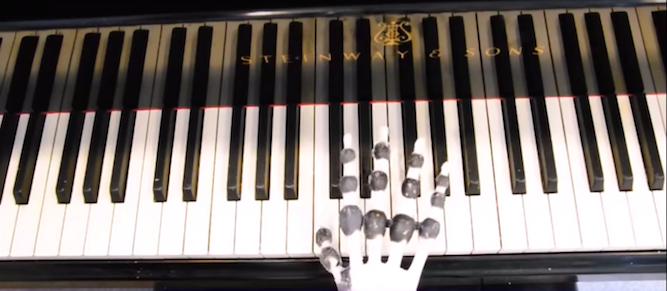Researchers from the University of Cambridge, UK have developed a 3D printed soft skeleton hand which can play simple musical phrases on the piano.
Without changing the mechanical properties or material of the hand, the robot could mimic styles of piano playing, such as staccato and legato, with a passive movement of the wrist, not its fingers.
The researchers 3D printed soft and rigid materials which replicated all of the bones and ligaments in a human hand. They were surprised to find how wide the range of movement was purely thanks to the hand’s mechanical design.
“We can use passivity to achieve a wide range of movement in robots: walking, swimming or flying, for example,” said Josie Hughes from Cambridge’s Department of Engineering, the paper’s first author. “Smart mechanical design enables us to achieve the maximum range of movement with minimal control costs: we wanted to see just how much movement we could get with mechanics alone.”
The Scientific Benefits of 3D Printing a “Virtuoso” Hand
The hand proves how complex movement can be achieved through design. It also indicates that future robot designs will be capable of more movement with minimal energy use.
“The basic motivation of this project is to understand embodied intelligence, that is, the intelligence in our mechanical body,” said Dr. Fumiya Iida, who led the research. “Our bodies consist of smart mechanical designs such as bones, ligaments, and skins that help us behave intelligently even without active brain-led control. By using the state-of-the-art 3D printing technology to print human-like soft hands, we are now able to explore the importance of physical designs, in isolation from active control, which is impossible to do with human piano players as the brain cannot be ‘switched off’ like our robot.”
As 3D printing technology advances, we are seeing an increase in how often soft components are integrated into robotic design. As a result, researchers can add complexity to passive systems more easily.
Although this research is limited, the researchers believe that the approach will drive further research in skeletal dynamics and the result could be complex movement tasks and an understanding of passive movement system limitations.
So, even though this hand isn’t up for the task, the researcher’s work could be the basis for developing a robot hand which could perform medical procedures…
Source: University of Cambridge

License: The text of "Cambridge Researchers 3D Print Piano-Playing Robotic Hand" by All3DP is licensed under a Creative Commons Attribution 4.0 International License.